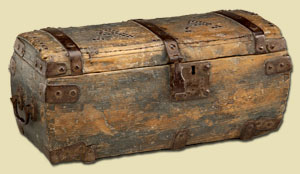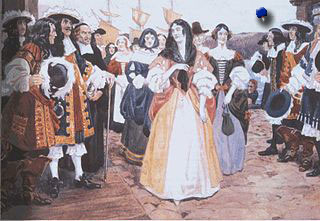les Filles du roi.
Kings Daughters.
Tradesmen were hired in France to build boats and villages in Québec in the early years of the 17th Century. A stable colony would insure continued access to valued commodities such as furs and fishing. Too many of these men, as high as three-quarters of them, returned to France at the end of their contracted period. Among the reasons was the lack of women to marry.
At first, France encouraged marriage with native women, even offering the brides a dowry and French citizenship. But more often than not assimilation ran in the opposite direction as the men left the service of the colony and went to live with neighboring tribes. So the Crown pivoted and began to actively discourage the unions.
There was an attempt to encourage migration and indeed some families did arrive. Though the wild and hostile Canadian frontier posed more of a threat than an opportunity, some intrepid souls, who came to be known as les Filles à marier, made the move prior to 1663 on their own. But the demand for wives continued to far outstrip the supply. The addition of several hundred soldiers sent to protect the community in 1665 only exacerbated the problem.
But what to do? The King agreed to provide a dowry and travel expenses for young women. Jean Talon, Intendant of Québec, proposed a set of criteria: they be of an age to procreate, and healthy. To that wish list was added "attractiveness" and "home skills" by the men in the colony.

During about a ten year period beginning in 1663 King Louis XIV sponsored over 760 young women by providing them with a dowry of 50 livres tournois or additional goods, and paying about 100 livres in expenses to recruit and transport them across the Atlantic. They received a chest equipped with two caps (coiffe), one of taffeta and one of gauze, a bonnet, gloves, shoes and stockings, belt, shoelaces, a comb, some ribbon, fine cloth and lace. Sewing supplies included white and grey thread, 100 needles, pins, a thimble, scissors and two knives. The program cost the King about 410,000 livres. For their part, the women had to provide references proving their good moral character, as well as birth records as proof of age.
The Jesuit Relations notes the arrivals in some of its writings. On 2 October 1665, "The ship from Normandy arrived with 82 girls and women--among others 50 from a charitable institution in Paris, where they have been well taught...", and in 1669-70, "His Majesty... has taken care to send over, a few (eight) months ago, 150 girls, in order that the Soldiers settling in New France may have families here, cultivate the lands, and defend the colony."
Once in Québec the girls were housed together under the supervision and tutelage of a chaperone. Savvy men understood the need for someone who could adapt to the rigors of the life they were to lead and soon showed a decided preference for country girls over city girls. For the most part the program attracted those of limited means, but did include members of the petty nobility who hoped to marry military officers.
Our Ancestors.
A number of our grandmothers took advantage of this opportunity. They are listed below with their year of arrival.

Family of Narcisse Petelle:
- Marie Faucon of Saintonge (1663).
- Marie DeBure of Normandie (1665).
- Barbe Ménard of LaRochelle (1669).
- Anne Lagou of Maine (1670).
- Georgette Richer of Bourgogne (1670).
- Catherine Ducharme of Paris (1671).
- Anne Leper (1673).
Family of Edesse Mondou:
- Catherine de Lalore of London (1671).
- Perrine LaPierre of Paris (1665).
- Jeanne Servignan of Bourgogne (1665).
- Jeanne Denot of Paris (1666).
- Marguerite Vaillant (1668).
- Marie Angelier (1669).
- Marie Richard of Champagne (1669).
- Marguerite Raisin (1670).
- Jeanne Petit of La Rochelle (1672).
- Marguerite Girard (1673).
- Chest image from: https://www.historymuseum.ca/virtual-museum-of-new-france/population/immigration/; © Canadian Museum of Civilization, no. 91-38, photo Harry Foster, D2007-08502
- https://www.thecanadianencyclopedia.ca/en/article/filles-du-roi/
- La Société des Filles du roi et soldats du Carignan https://www.fillesduroi.org/cpage.php?pt=9
- Migrations https://www.migrations.fr/page%20d'accueil.htm
- https://commons.wikimedia.org/wiki/File:The_Arrival_of_the_French_Girls_at_Quebec,_1667_-_C.W._Jefferys.jpg
- Lost in Canada, p 85
- Sent by the King, Journal of the SFRSC, Spring 2017 by Marcia Zug, from Lonely Colonists Seeks Wife: The Forgotten History of America's First Mail Brides
